ISSN ONLINE(2319-8753)PRINT(2347-6710)
ISSN ONLINE(2319-8753)PRINT(2347-6710)
Raman Sharma1, Om Pal Singh2
|
| Related article at Pubmed, Scholar Google |
Visit for more related articles at International Journal of Innovative Research in Science, Engineering and Technology
Friction Stir Welding (FSW) is considered to be the most significant development in metal joining during last decade. This joining technique is energy efficient, environment friendly for versatile alloys. In the present work an effort has been made to join the polymeric material (Polypropylene) by FSW technique and the effects of critical process parameters on mechanical properties i.e. tensile and impact strength of friction stir welded polypropylene have been studied. Three process parameters i.e., tool rotational speed; welding speed and tool diameter were taken as process variables. Taguchi L27 Orthogonal Array method was selected for conducting the experiments. Experiments were performed at rotational speeds of 600, 750 and 900 r/min, welding speeds of 60, 70, and 80 mm/min, and tool diameters of 8, 10 and 12 mm. A strength value of 80% of the base material was achieved at the isolated optimum welding condition.For generating graphs and analysing themsoftware Mini Tab 14 was used.
Keywords |
| Friction Stir Welding, Mechanical Properties, Polypropylene, Taguchi Approach. |
I. INTRODUCTION |
| Friction stir welding is an innovative solid state welding process invented in December, 1991 by Wayne Thomas at The Welding Institute (TWI), Cambridge, United Kingdom. It has been found as one of the most significant welding process invention from the last two decades. It can be considered as a hot working process in which a large amount of a deformation is imparted to the work piece through the rotating pin and the shoulder [1]. No melting occurs in this process and the developed welds have a fine grained, hot worked condition with no entrapped oxides or gas porosity. No shielding gas or flux is used. The joining does not involve any use of filler metal. Friction stir welding is a variant of friction welding that produces a weld between two work pieces by heating and plastic displacement caused by a rapidly rotating tool that traverse the weld joint. Heating is done by both frictional rubbing between the tool and the work pieces and by visco-plastic dissipation of the deforming material at high strain rates. Friction stir welding uses a non-consumable, rotating welding tool to create heat locally. The rotating tool hot works the material surrounding the weld interface to produce a continuous solid state weld. |
| While metals are currently being used for many applications, and new metal alloys are being developed, more parts are being designed and manufactured using plastic and composite materials. Likewise, existing parts that are currently made with metals are being redesigned and manufactured with plastic materials. |
| Despite the continuous improvements and development of new plastic materials, the processes used to fabricate final products are often inadequate retention. While, several new processes have been developed to meet the need for producing large volumes of quality plastic parts, there is still a need for a process for joining plastic materials, particularly for structural and high performance applications. Unfortunately, plastics can be difficult to join due to their low surface energies, poor weldability, and the presence of release agents from previous processing steps. |
| If friction stir welding could be applied to plastics, it would offer many advantages ranging from cost reductions to the ability to weld fairly complex, flat joints. Here Friction stir welding being a new welding technique has been experimented for the welding of plastic material. |
II. LITERATURE SURVEY |
| Many researchers investigated and formulated the effect of friction stir welding which has produced structural joints superior to conventional arc welds in Aluminium, Steel, Nickel, Copper and Titanium alloy. Research and development efforts over the last decade have resulted in improvements in friction stir welding and the spin-off of a series of related technologies. |
| A. Arici [2] investigated the effect of tool tilt angle on friction stir welding (FSW) of polyethylene (PE). The tensile strength decreased with increasing tool tilt angle. The thickness of the welding zone decreased with increasing tool tilt angle which affects the tensile strength. |
| Erica Anna Squeo [3] performed friction stir welding of 3 mm thick Polyethylene sheets with a cylindrical steel pin with two pin diameters. Author has concluded that even if process optimization is required, the final performances of the joints are sufficient to assess that friction stir welding of polyethylene may be a valid alternative to conventional joining technologies. |
| Erica Anna Squeo [3] performed friction stir welding of 3 mm thick Polyethylene sheets with a cylindrical steel pin with two pin diameters. Author has concluded that even if process optimization is required, the final performances of the joints are sufficient to assess that friction stir welding of polyethylene may be a valid alternative to conventional joining technologies. |
| Mustafa Aydin [5] investigated the weldability of UHMW-polyethylene via friction stir welding method. In this study, three different heating processes were used. These processes are welding at room temperature, welding by preheating from the bottom of plastic samples at 50°C and 80°C with metal molding. In the experiments, a tensile strength of 72% was achieved in non-preheated welds whereas tensile strength of parent material was achieved approximately at an optimum value of 89% by pre-heating at 50°C. |
| S Saeedy [6] studied the effect that varying process parameters (rotational speed, welding speed, and attack angle) had on the weld quality of polyethylene sheets. A strength value of 75 per cent of that of the base material was achieved at the isolated optimum welding condition. G. H. Payganeh [7] used friction stir welding for butt joining polypropylene composite plates having 30% glass fiber by weight. The results indicated that tool pin geometry had a significant influence on weld quality and the effects of rotational speed and tilt angle on weld appearance and strength were more than that of work linear speed. |
III. EXPERIMENTATION |
| The friction stir welding process was performed on a CNC vertical milling machine installed in Machine shop of Industrial Training institute Solan (HP). The specially designed fixture was clamped on bed of vertical milling machine. The tool was mounted on the vertical spindle. Then two prepared Polypropylene pieces were clamped into the fixture. Then the rotating tool was made to embed into the butt joint. Then after some time, when there was sufficient heating was achieved due to friction between tool and plates, the spindle was given automatic feed, along the joint direction. Thus the welding was achieved. |
| The selected input process parameters with their designation are listed in Table 1 and Table 2 enlists levels of process parameters and assigned values of process parameters at these levels and their designation for experimental work. |
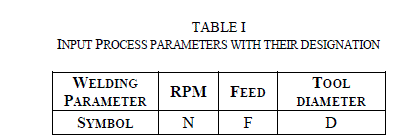 |
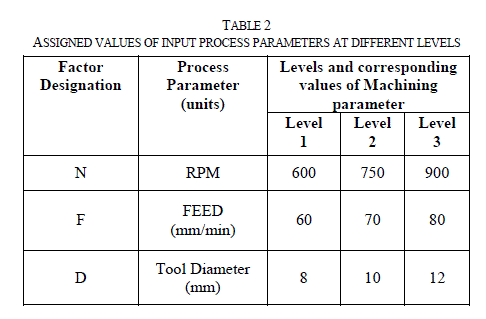 |
| Total 27 experiments were performed for one set of observation. The welding parameters were selected as per design matrix. The trials were repeatedly three times for determining the adequacy of mathematical models. Thus total 81(27x3) trials were performed. |
| After that the pieces were cut into the samples of required dimensions as per ASTM standards Designation: B 557 M – 07 (Figure 1) and D 6110 – 02 (Figure 2) for performing the tensile tests, and impact tests respectively. |
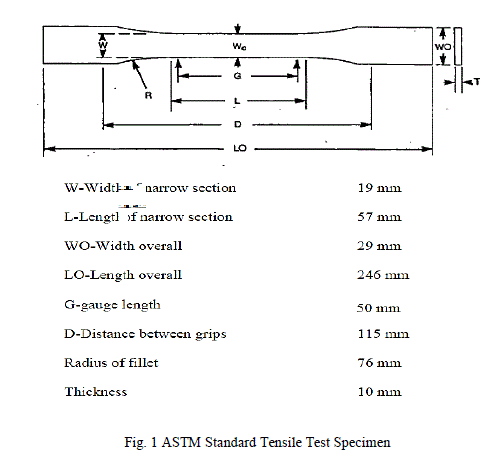 |
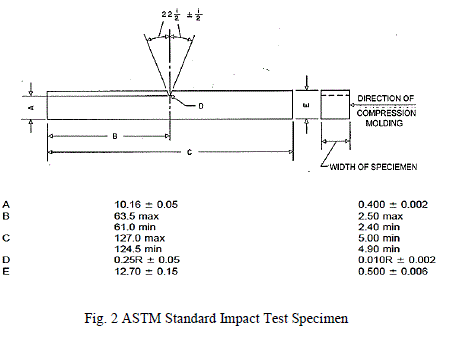 |
IV. RESULTS AND DISCUSSIONS |
| From the observations and the graphs generated using MiniTAB 14 software, the effects of process variables on mechanical properties have been discussed below: |
| A. Influence of RPM on Tensile Strength |
| Figure 3 shows that at higher (900 rpm) spindle speed tensile strength is maximum. This could be caused by the large amount of heat generated by the high spindle speed. This large heat increased weld temperature which affects the melted material as well as the untouched base material, it fuses with upon cooling. At higher temperatures, fusion at the interfacial boundary improves, producing a more homogeneous joint with improved mechanical properties. |
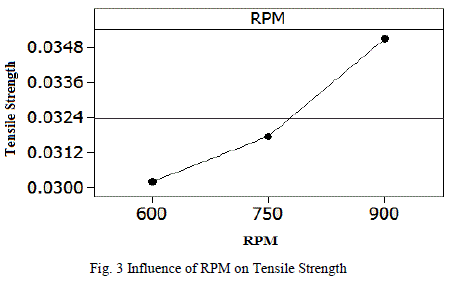 |
| B. Influence of Tool Pin Diameter on Tensile Strength |
| Figure 4 shows that the tensile strength is maximum at 2nd level of tool pin diameter. The pin with smaller diameter has a smaller surface area than the pin of larger diameter; therefore at same RPM the surface speed of the rotating larger diameter pin is greater than the surface speed of the rotating smaller diameter pin. The higher surface speed would generate more heat due to friction, thus helping the weld fuse better to the base material. But at very large diameters surface speed becomes too large as a result it flushes the material out or swirls the material resulting in a weaker joint. So results are best between the smallest and the largest tool pin diameter. |
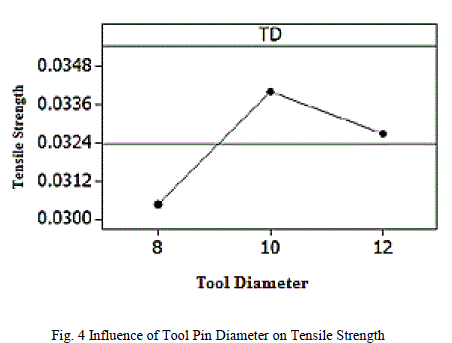 |
| C. Influence of Feed Rate on Tensile Strength |
| Figure 5 shows that the tensile strength is maximum at 2nd level of feed rate. This may be due to the reason that at lowest feed rate the heat input was very high which degraded the base material. At highest feed rate the heat generated was not sufficient to soften the base material &the weld resulted into a weak joint. |
| At moderate feed rate it was observed that the joints were highly satisfactory with better mechanical properties. This may be due to the heat generated which was enough to soften the base material without any degradation and flushes. |
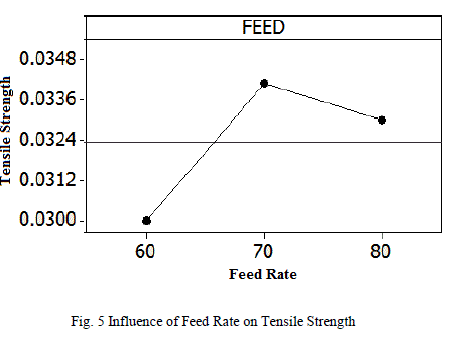 |
| D. Influence of RPM on Impact Strength |
| Figure 6 shows that at higher (900 rpm) spindle speed Impact Strength is maximum. This could be caused by the large amount of heat generated by the high spindle speed. This large heat increased weld temperature which affects the melted material as well as the untouched base material, it fuses with upon cooling. At higher temperatures, fusion at the interfacial boundary improves, producing a more homogeneous joint with improved mechanical properties. |
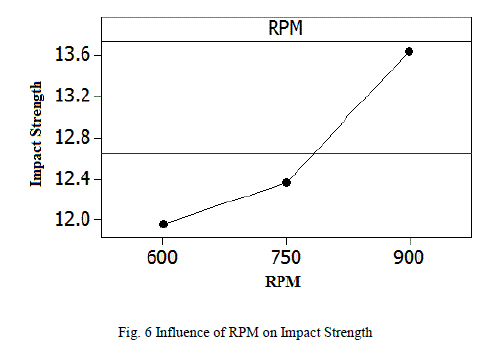 |
| E. Influence of Tool pin diameter on Impact Strength |
| Figure 7 shows that the strength is maximum at 2nd level of tool pin diameter. The pin with smaller diameter has a smaller surface area than the pin of larger diameter; therefore at same RPM the surface speed of the rotating larger diameter pin is greater than the surface speed of the rotating smaller diameter pin. The higher surface speed would generate more heat due to friction, thus helping the weld fuse better to the base material. But at very large diameters surface speed becomes too large as a result it flushes the material out or swirls the material resulting in a weaker joint. So results are best between the smallest and the largest tool pin diameter. |
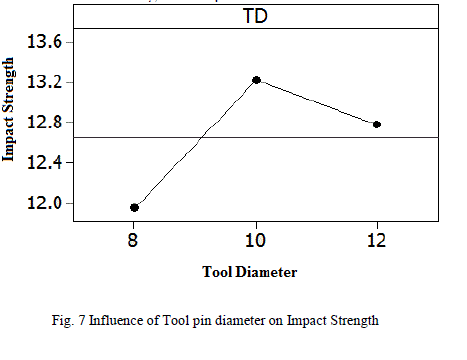 |
| F. Influence of feed rate on Impact Strength |
| Figure 8 shows that impact strength is maximum at 2nd level of feed rate. This may be due to the reason that at lowest feed rate the heat input was very high which degraded the base material. At highest feed rate the heat generated was not sufficient to soften the base material &the weld resulted into a weak joint. |
| At moderate feed rate it was observed that the joints were highly satisfactory with better mechanical properties. This may be due to the heat generated which was enough to soften the base material without any degradation and flushes. |
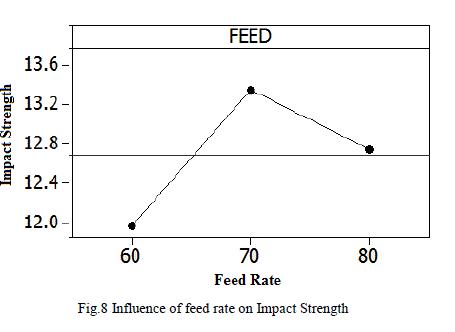 |
V. CONCLUSION |
| • The optimized parameters for the FSW process of polypropylene for tensile strength were found as rpm 900, tool diameter 10mm, feed 70mm/min, and for impact strength are rpm 900, tool diameter 10mm and feed 70mm/min. |
| • The tensile strength of friction stir welded joint was found to be 80% of base material at optimized parameters.c |
| • Tensile strength first increases and thendecreases with the increase in welding speed. |
| • Tensile strength first increases and thendecreases with the increase in welding speed. |
| • Tensile strength increases with increase in rotational speed of tool. |
| • Tensile strength first increases and then decreases with increase in tool diameter. |
| • The optimized parameters for the FSW process of polypropylene for impact strength were found as rpm 900, tool diameter 10mm, feed 70mm/min. |
| • With increase in probe rotational speed, there is increase in impact strength. |
| • Impact strength first increases and then decreases with the increase in welding speed. Impact strength also first increases and then decreases with the increase in tool diameter. |
References |
|